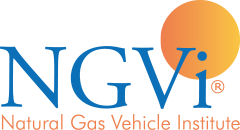By Kasia McBride, Marketing Manager, NGVi
As gasoline and diesel continue their unstable pricing pattern, dictated by the global energy market, natural gas remains inexpensive and steady. Using natural gas as a transportation fuel is still more cost-effective—especially for the medium- and heavy-duty truck applications.
According to a recent count by the International Association of Natural Gas Vehicles, there are more than 16 million natural gas vehicles operating worldwide, with over 160,000 in the United States. NGVs are among the safest vehicles driving on the road today. Yet, as more of them deploy, drivers must be adequately trained on the properties and characteristics of the fuel itself. They must also learn all necessary safety precautions and techniques while operating and fueling natural gas vehicles.
Since natural gas is a vapor and not a liquid, it has unique characteristics that distinguish it from other fuels. For instance, because it is lighter than air, natural gas will rise if leaked instead of pooling on the ground like, gasoline and diesel. It is either highly compressed or liquefied before it is stored onboard vehicles and thus requires different fueling equipment, procedures, safety protocols and handling.
Because of their daily operation and fueling of natural gas vehicles, drivers and fuel handlers must be able to identify and use CNG fueling station equipment and safety components. They should know how to locate and use emergency shutdown devices, quarter-turn manual shut-off valves, fire extinguishers, and other safety equipment.
Drivers and fuel handlers must also follow the specific steps and precautions involved in fueling CNG-powered vehicles. They should know what to expect during the fueling process. This procedure differs from traditional gasoline or diesel vehicles because it involves transferring high-pressure gas instead of merely pumping a liquid.
While fueling an NGV, for example, it is normal for a small amount of gas to escape the nozzle/receptacle connection when they are disconnected. Drivers may be able to detect the smell of gas for a brief period of time. Also, when fast-filling an NGV, it is normal that drivers may hear a whining sound which indicates that the vehicle is almost full. A lasting scent, however, or a distinct hiss that lingers is not normal and should be reported to fueling station maintenance.
It is also imperative that drivers and fuel handlers are able to identify the safety hazards and know what to do when they occur. For instance, they must remember to visually check O-rings before each fueling. An O-ring is fitted in the receptacle to ensure a gas-tight seal between the fueling nozzle and the receptacle. Whether fueling a heavy- or light-duty NGV, if the O-ring is missing or damaged, there may be a fueling failure. In this case, drivers should not connect the fill nozzle to the receptacle and they should have the missing O-ring replaced before attempting to fuel the vehicle.
Although natural gas vehicles have a solid safety record and there are a very low number of incidents involving NGVs, drivers need to know what safety protocols they should follow in case of emergency. On the vehicle side, they need to know what procedures to use in case of vehicle accident or fire, if a receptacle is leaking, and what to do if a heavy-duty vehicle’s methane detection system is activated. At the CNG fueling station, they should know what to do in case of fueling station accident or fire, major gas release, and in case of emergencies such as an earthquake or vandalism. For example, drivers and fuel handlers should know what to do if they encounter equipment warning lights or audible alarms at a CNG station.
Operating and fueling NGVs requires special awareness of safety procedures that are unique to these vehicles. Understanding NGVs and the technology for both vehicles and fueling can minimize the risk of accident in the shop, on the road or at a fueling station. In this new era when NGVs are becoming more and more prevalent, adequate training for vehicle drivers on the unique fuel systems and operating characteristics for NGVs is a must. For more information about online Natural Gas Vehicle Driver and Fueling Training, visit www. ngvi.com/driver_safety.html.
